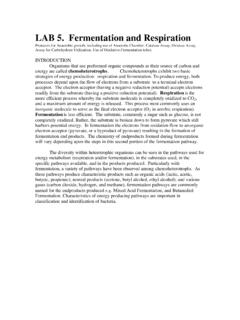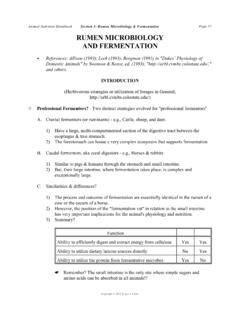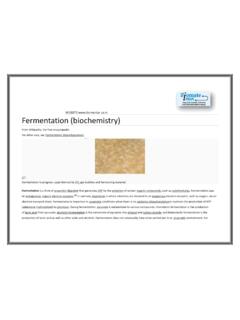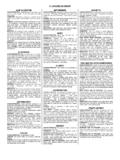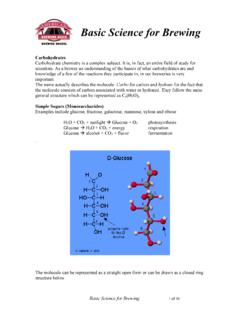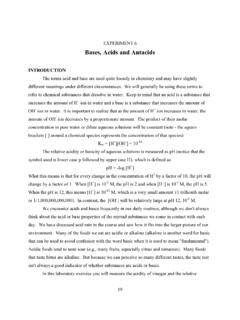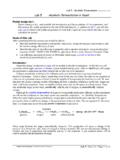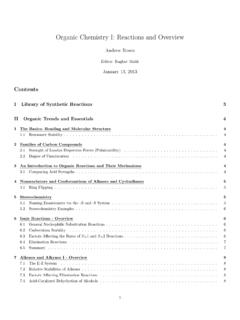Transcription of BIOCHEMISTRY LABORATORY MANUAL CHE 4350
1 BONHAM CHE 4350 SPRING 2013 1 BIOCHEMISTRY LABORATORY MANUAL CHE 4350 Andrew J. Bonham, , AnnaMarie Drotar, , Kelly M. Elkins, Ph. D. BONHAM CHE 4350 SPRING 2013 2 TABLE OF CONTENTS Title Page 1 Table of Contents 2 Introduction 3 LABORATORY Safety 4-6 Avoiding Contamination Issues 7 Module 1: BIOCHEMISTRY LABORATORY Basic Skills 8 1 Scientific papers, lab notebooks, and the science of BIOCHEMISTRY 9-10 2 Pipetting & Buffer preparation 11-18 Module 2.
2 Protein Purification and Characterization 19 Introduction & Purification Scheme 19 3 Resin elution from lysed yeast 20-21 4 Ammonium sulfate precipitation and in silico protein investigation 22-28 5 Cation-exchange column chromatography 29-32 6 Protein characterization and quantification by UV-Vis & Bradford assay 33-40 7 SDS-polyacrylamide gel electrophoresis (SDS-PAGE) 41-46 8 Cyclic voltammetry or activity assay of Cytochrome c redox 47-49 Module 3: DNA Modifying Enzymes & Molecular Cloning 50 9 DNA Purification of plasmid and Primer Design 51-55 10 PCR and and in silico protein cloning 56-60 11 Restriction digest and ligation of PCR and plasmid vector 61-62 12 Agarose gel electrophoresis 63-65 13 Bacterial transformation of ligation products 66-67 Module 4: Enzyme Kinetics 68 14 Kinetics of Tyrosinase 69-73 15 Inhibition of Tyrosinase 74-77 Appendix.
3 Formal research lab reports in the style of BIOCHEMISTRY 78-79 BONHAM CHE 4350 SPRING 2013 3 WELCOME TO THE BIOCHEMISTRY LABORATORY ! This BIOCHEMISTRY LABORATORY seeks to model work performed in a biochemical research LABORATORY . The course will guide you through basic lab techniques, investigations into DNA and enzyme kinetics, an intensive purification and characterization of an unreported protein, and will culminate in a formal research paper in the format of an article published in BIOCHEMISTRY . Module 1 is concerned with basic lab skills.
4 In these labs, we will learn how scientists think and write about BIOCHEMISTRY and perform experiments. We will also learn to accurately and precisely measure small volume of liquid while avoiding sample contamination. Lastly, we will learn to compute and create buffer solutions a cornerstone of BIOCHEMISTRY . Module 2 will allow us to purify the protein cytochrome c from a yeast species (Saccharomyces cerevisiae) using various fractionation techniques including homogenization, centrifugation, and column chromatography. We will characterize our products using biochemical methods including gel electrophoresis, UV-Vis spectroscopy, and electrochemistry.
5 Using modeling software on the computer, the structure and function of model, comparison cytochrome c proteins will be investigated. As a result of this project, we will determine the molecular weight, the approximate number and type of aromatic residues, characteristic UV-Vis spectra, and denaturation/renaturation properties of cyctochrome c. Module 3 looks into the processes used to isolate, purify, amplify, and characterize DNA. We will isolate and purify DNA from a bacterial source, and design and then use then use the polymerase chain reaction (PCR) to amplify a DNA region of interest to ascertain the nature of the DNA we purified.
6 Finally, we will perform in silico studies of DNA cloning, followed by DNA restriction and ligation for transformation into a bacterial expression system molecular cloning. Module 4 is focused on enzyme kinetics, the measurement of the extent and mechanism by which enzymes catalyze biological reactions. We will investigate these processes by looking at the activity of tyrosinase found in mushrooms, which catalyze oxidation of various substrates. We will also investigate the effect of enzyme inhibitors of these reactions. The emphasis of the lab is on learning to perform complex biochemical techniques, as well as on analyzing and interpreting data and using graphing programs.
7 Lab instructions and report expectations are explained in the pages that follow. BONHAM CHE 4350 SPRING 2013 4 LABORATORY Safety Rules for a Safe Lab Environment Safety in the chemistry LABORATORY involves a cautious attitude and an awareness of potential hazards. Usually potential accidents can be anticipated and prevented. If safety precautions are followed, fewer accidents will occur. The number of LABORATORY accidents can be reduced if every student follows all of the directions given for the experiment and by the instructor.
8 Special note should be taken of specific instructions that are given in an experiment to eliminate recognized potential hazards. A. General Regulations 1. MSUD is not responsible for damage to personal effects. 2. Whenever students are performing authorized experiments in the LABORATORY , an instructor is expected to be present or a student needs explicit permission from the instructor to work in the LABORATORY in which case the student must have a partner present in the lab. 3. Any breakage of glassware or other breakable LABORATORY equipment is to be immediately reported to the LABORATORY instructor.
9 DO NOT CLEAN UP THE BROKEN GLASS. Your LABORATORY instructor will clean up and dispose of all broken glassware and equipment. 4. Electronic devices, such as cellular phones and pagers, and any personal entertainment devices must be turned off prior to the beginning of the lab period. Failure to comply will result in dismissal. 5. No visitors should attend class without the prior consent of the instructor 6. Failure to comply with LABORATORY rules and regulations will result in expulsion from the LABORATORY and referral to the Department Chair for further action. B. Student Responsibility 1.
10 LOCATE THE SAFETY EQUIPMENT. Find the eyewash, safety shower, fire extinguishers, fire blanket, first-aid kit and all exits that are to be used in an emergency. 2. PROTECT YOUR EYES. Eye protection (safety goggles) are to be worn at all times while working in the LABORATORY room. Failure to abide by this policy will result in expulsion from the lab and a grade of zero for the assigned lab experiment. 3. LONG HAIR NEEDS TO BE PULLED BACK. 4. SHOES WORN TO LAB MUST COVER YOUR FEET COMPLETELY. Since broken glass and spilled chemicals are all too common occurrences in lab, your feet will need more protection than that afforded by open-toed shoes or sandals.
